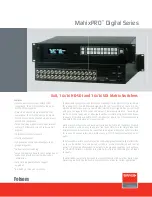
destination switches), and a destination session (destination ports connected to analyzers on destination
switches).
Configuration Notes
When you configure remote port mirroring, the following conditions apply:
• You can configure any switch in the network with source ports and destination ports, and allow it to
function in an intermediate transport session for a reserved VLAN at the same time for multiple
remote-port mirroring sessions. You can enable and disable individual mirroring sessions.
• BPDU monitoring is not required to use remote port mirroring.
• A remote port mirroring session mirrors monitored traffic by prefixing the reserved VLAN tag to
monitored packets so that they are copied to the reserve VLAN.
• Mirrored traffic is transported across the network using 802.1Q-in-802.1Q tunneling. The source
address, destination address and original VLAN ID of the mirrored packet are preserved with the
tagged VLAN header. Untagged source packets are tagged with the reserve VLAN ID.
• The RPM VLAN can’t be a Private VLAN.
• The RPM VLAN can be used as GVRP VLAN.
• The L3 interface configuration should be blocked for RPM VLAN.
• The member port of the reserved VLAN should have MTU and IPMTU value as MAX+4 (to hold the
VLAN tag parameter).
• To associate with source session, the reserved VLAN can have at max of only 4 member ports.
• To associate with destination session, the reserved VLAN can have multiple member ports.
• Reserved Vlan cannot have untagged ports
In the reserved
L2 VLAN
used for remote port mirroring:
• MAC address learning in the reserved VLAN is automatically disabled.
• The reserved VLAN for remote port mirroring can be automatically configured in intermediate
switches by using GVRP.
• There is no restriction on the VLAN IDs used for the reserved remote-mirroring VLAN. Valid VLAN IDs
are from 2 to 4094. The default VLAN ID is not supported.
• In mirrored traffic, packets that have the same destination MAC address as an intermediate or
destination switch in the path used by the reserved VLAN to transport the mirrored traffic are dropped
by the switch that receives the traffic if the switch has a L3 VLAN configured.
In a
source session
used for remote port mirroring:
• Maximum number of source sessions supported on a switch: 4
• Maximum number of source ports supported in a source session: 128
• You can configure physical ports and port-channels as sources in remote port mirroring and use
them in the same source session. You can use both Layer 2 (configured with the switchport
command) and Layer 3 ports as source ports. You can optionally configure one or more source
VLANs to specify the VLAN traffic to be mirrored on source ports.
• You can use the default VLAN and native VLANs as a source VLAN.
• You cannot configure the dedicated VLAN used to transport mirrored traffic as a source VLAN.
• Egressing remote-vlan packets are rate limited to a default value of 100 Mbps.
In a
destination session
used for remote port mirroring:
Port Monitoring
759
Summary of Contents for S4820T
Page 1: ...Dell Configuration Guide for the S4820T System 9 8 0 0 ...
Page 282: ...Dell 282 Control Plane Policing CoPP ...
Page 622: ...Figure 81 Configuring Interfaces for MSDP 622 Multicast Source Discovery Protocol MSDP ...
Page 623: ...Figure 82 Configuring OSPF and BGP for MSDP Multicast Source Discovery Protocol MSDP 623 ...
Page 629: ...Figure 86 MSDP Default Peer Scenario 2 Multicast Source Discovery Protocol MSDP 629 ...
Page 630: ...Figure 87 MSDP Default Peer Scenario 3 630 Multicast Source Discovery Protocol MSDP ...
Page 751: ...10 11 5 2 00 00 05 00 02 04 Member Ports Te 1 2 1 PIM Source Specific Mode PIM SSM 751 ...
Page 905: ...Figure 112 Single and Double Tag First byte TPID Match Service Provider Bridging 905 ...
Page 979: ...6 Member not present 7 Member not present Stacking 979 ...
Page 981: ...storm control Storm Control 981 ...
Page 1103: ...Figure 134 Setup OSPF and Static Routes Virtual Routing and Forwarding VRF 1103 ...
















































